seat rear TOYOTA LAND CRUISER 2017 J200 Owners Manual
[x] Cancel search | Manufacturer: TOYOTA, Model Year: 2017, Model line: LAND CRUISER, Model: TOYOTA LAND CRUISER 2017 J200Pages: 608, PDF Size: 15.88 MB
Page 2 of 608

TABLE OF CONTENTS2
LC200_OM_OM60P24U_(U)For your information....................... 8
Reading this manual .................... 12
How to search .............................. 13
Pictorial index .............................. 14
1-1. For safe use
Before driving ...................... 26
For safety drive ................... 28
Seat belts ............................ 30
SRS airbags ........................ 38
Front passenger occupant classification system ......... 51
Safety information for children ............................. 57
Child restraint systems ........ 58
Installing child restraints ...... 63
Exhaust gas precautions ..... 73
1-2. Theft deterrent system Engine immobilizer system............................... 74
Alarm ................................... 76
2. Instrument cluster Warning lights and indicators........................... 80
Gauges and meters............. 85
Multi-information display ..... 89
Fuel consumption information ........................ 98 3-1. Key information
Keys................................... 102
3-2. Opening, closing and locking the doors
Side doors ......................... 106
Back door .......................... 114
Smart key system .............. 120
3-3. Adjusting the seats Front seats......................... 127
Rear seats ......................... 129
Driving position memory .... 136
Head restraints .................. 140
3-4. Adjusting the steering wheel and mirrors
Steering wheel ................... 143
Inside rear view mirror ....... 145
Outside rear view mirrors ............................. 147
3-5. Opening, closing the windows and moon roof
Power windows.................. 150
Moon roof .......................... 154
1For safety and security
2Instrument cluster
3Operation of each
component
Page 4 of 608

TABLE OF CONTENTS4
LC200_OM_OM60P24U_(U)5-1. Using the air conditioning
system and defogger
Front automatic air conditioning system ........ 374
Rear air conditioning system............................. 385
Heated steering wheel/ seat heaters/
seat ventilators ................ 389
5-2. Using the interior lights Interior lights list ................ 393• Interior lights ................. 394
• Personal lights .............. 395
5-3. Using the storage features List of storage features...... 396• Glove box...................... 397
• Console box .................. 398
• Overhead console ......... 399
• Cup holders .................. 400
• Bottle holders ................ 402
• Card holders ................. 403
• Auxiliary boxes .............. 403
Luggage compartment features ........................... 404 5-4. Using the other interior
features
Other interior features........ 406 • Cool box ........................ 406
• Sun visors ..................... 408
• Vanity mirror .................. 408
• Clock ............................. 409
• Outside temperature
display ........................... 409
• Power outlets ................ 410
• Wireless charger ........... 412
• Armrest.......................... 420
• Coat hooks .................... 420
• Assist grips .................... 421
Garage door opener .......... 422
Safety Connect .................. 427
5Interior features
Page 6 of 608
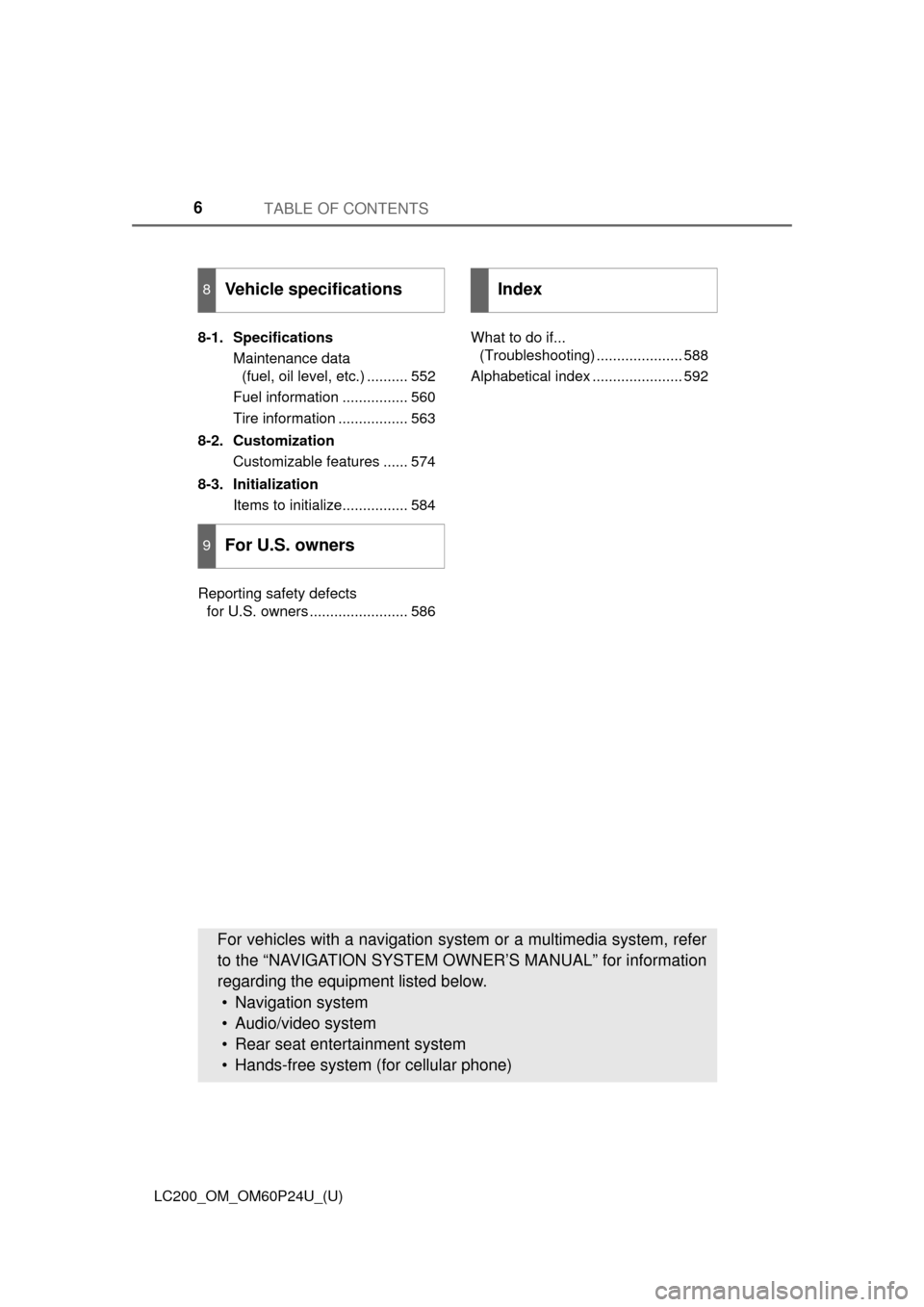
TABLE OF CONTENTS6
LC200_OM_OM60P24U_(U)8-1. Specifications
Maintenance data (fuel, oil level, etc.) .......... 552
Fuel information ................ 560
Tire information ................. 563
8-2. Customization Customizable features ...... 574
8-3. Initialization Items to initialize................ 584
Reporting safety defects for U.S. owners ........................ 586 What to do if...
(Troubleshooting) ..................... 588
Alphabetical index ...................... 592
8Vehicle specifications
9For U.S. owners
Index
For vehicles with a navigation system or a mu ltimedia system, refer
to the “NAVIGATION SYSTEM OWNER’S MANUAL” for information
regarding the equipment listed below. • Navigation system
• Audio/video system
• Rear seat entertainment system
• Hands-free system (for cellular phone)
Page 22 of 608
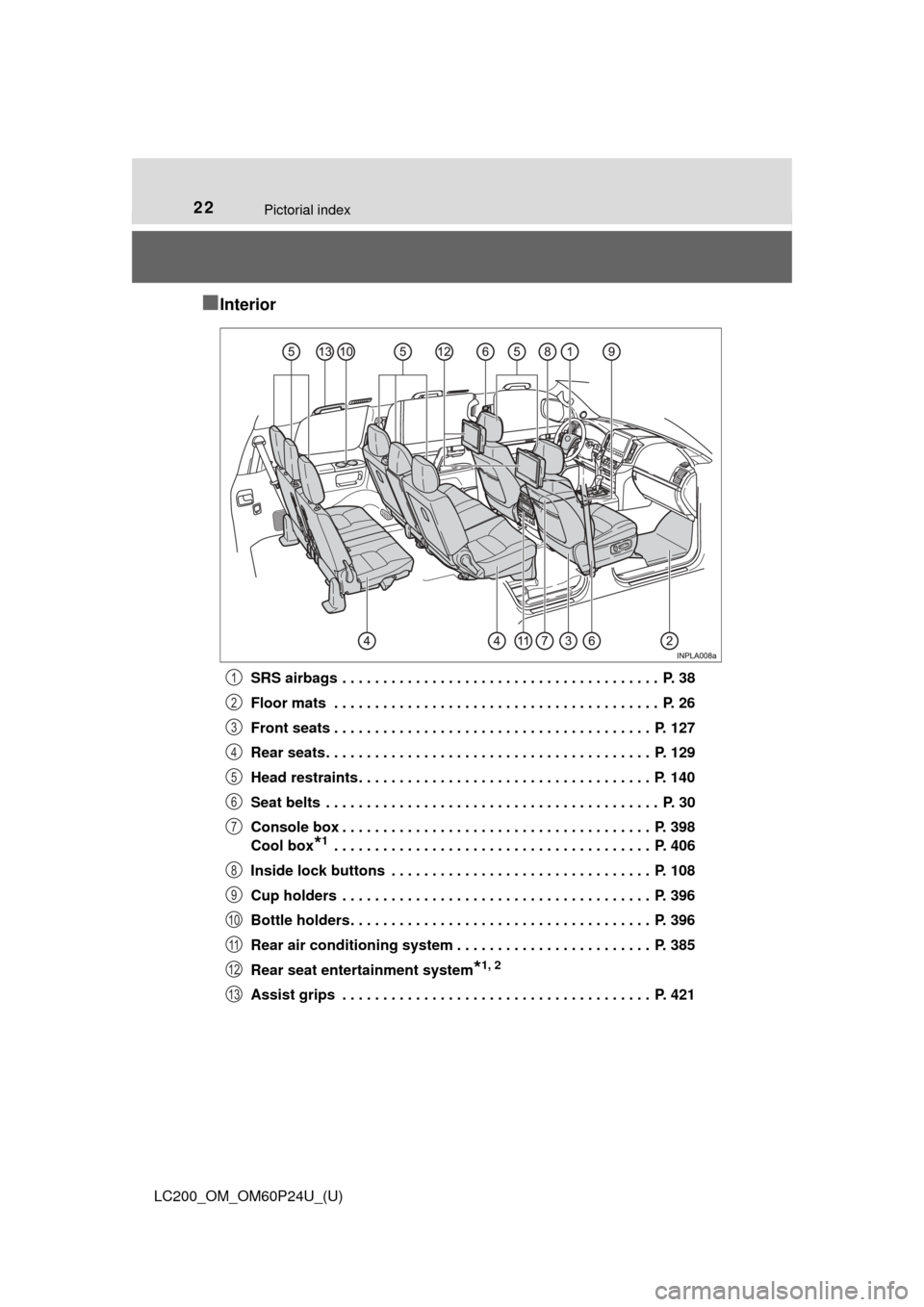
22Pictorial index
LC200_OM_OM60P24U_(U)
■Interior
SRS airbags . . . . . . . . . . . . . . . . . . . . . . . . . . . . . . . . . . . . . . . P. 38
Floor mats . . . . . . . . . . . . . . . . . . . . . . . . . . . . . . . . . . . . . . . . P. 26
Front seats . . . . . . . . . . . . . . . . . . . . . . . . . . . . . . . . . . . . . . . P. 127
Rear seats . . . . . . . . . . . . . . . . . . . . . . . . . . . . . . . . . . . . . . . . P. 129
Head restraints . . . . . . . . . . . . . . . . . . . . . . . . . . . . . . . . . . . . P. 140
Seat belts . . . . . . . . . . . . . . . . . . . . . . . . . . . . . . . . . . . . . . . . . P. 30
Console box . . . . . . . . . . . . . . . . . . . . . . . . . . . . . . . . . . . . . . P. 398
Cool box
*1 . . . . . . . . . . . . . . . . . . . . . . . . . . . . . . . . . . . . . . . P. 406
Inside lock buttons . . . . . . . . . . . . . . . . . . . . . . . . . . . . . . . . P. 108
Cup holders . . . . . . . . . . . . . . . . . . . . . . . . . . . . . . . . . . . . . . P. 396
Bottle holders . . . . . . . . . . . . . . . . . . . . . . . . . . . . . . . . . . . . . P. 396
Rear air conditioning system . . . . . . . . . . . . . . . . . . . . . . . . P. 385
Rear seat entertainment system
*1, 2
Assist grips . . . . . . . . . . . . . . . . . . . . . . . . . . . . . . . . . . . . . . P. 421
1
2
3
4
5
6
7
8
9
10
11
12
13
Page 29 of 608

291-1. For safe use
LC200_OM_OM60P24U_(U)
1
For safety and security
Make sure that you can see backward clearly by adjusting the inside
and outside rear view mirrors properly. (→P. 145, 147)
Adjusting the mirrors
WARNING
Observe the following precautions.
Failure to do so may result in death or serious injury.
● Do not adjust the position of the driver’s seat while driving.
Doing so could cause the driver to lose control of the vehicle.
● Do not place a cushion between the driver or passenger and the seatback.
A cushion may prevent correct posture from being achieved, and reduce
the effectiveness of the seat belt and head restraint.
● Do not place anything under the front seats.
Objects placed under the front seats may become jammed in the seat
tracks and stop the seat from locking in place. This may lead to an acci-
dent and the adjustment mechanism may also be damaged.
● Always observe the legal speed limit when driving on public roads.
● When driving over long distances, take regular breaks before you start to
feel tired.
Also, if you feel tired or sleepy while driving, do not force yourself to con-
tinue driving and take a break immediately.
Page 33 of 608
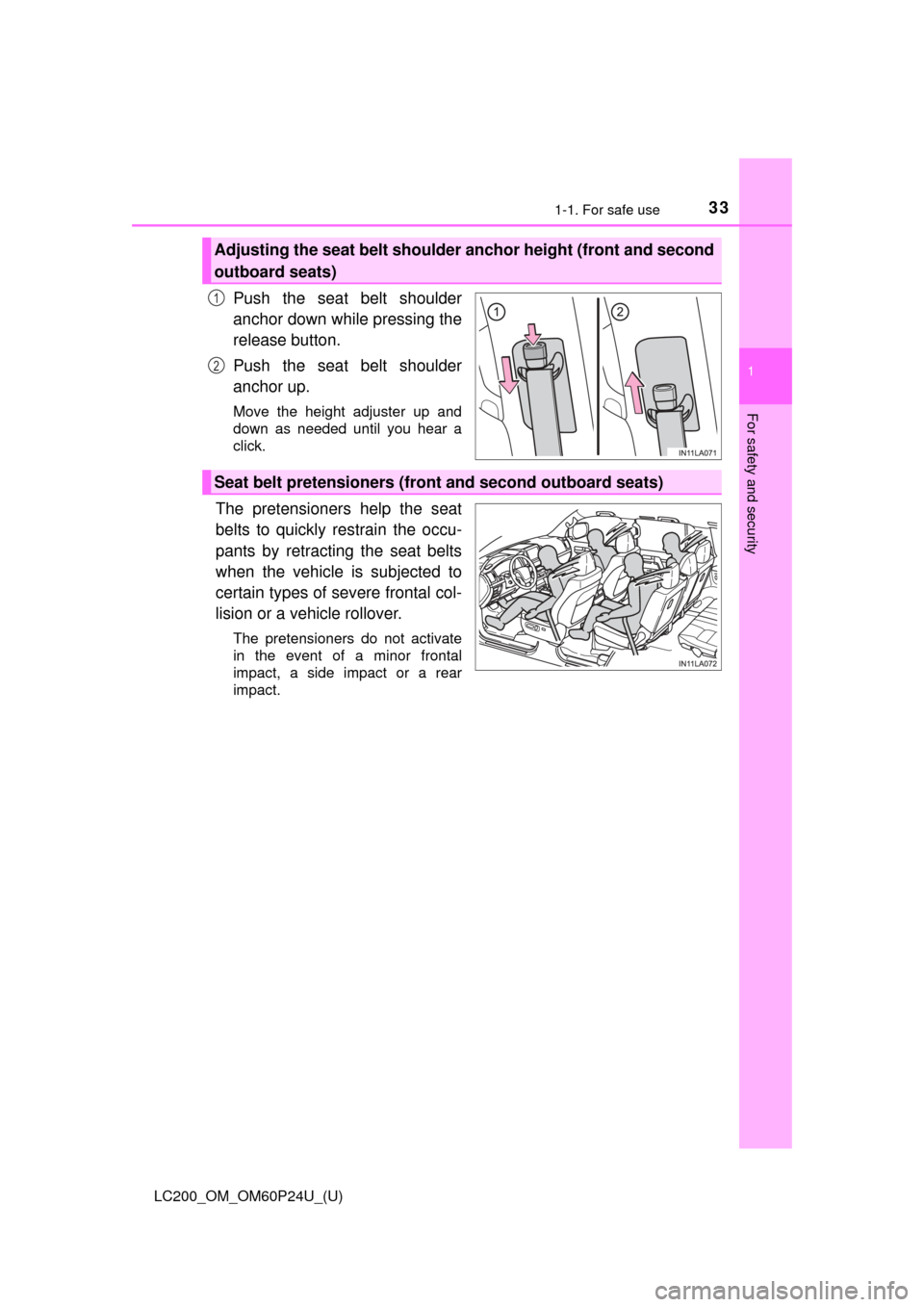
331-1. For safe use
LC200_OM_OM60P24U_(U)
1
For safety and security
Push the seat belt shoulder
anchor down while pressing the
release button.
Push the seat belt shoulder
anchor up.
Move the height adjuster up and
down as needed until you hear a
click.
The pretensioners help the seat
belts to quickly restrain the occu-
pants by retracting the seat belts
when the vehicle is subjected to
certain types of severe frontal col-
lision or a vehicle rollover.
The pretensioners do not activate
in the event of a minor frontal
impact, a side impact or a rear
impact.
Adjusting the seat belt shoulder anchor height (front and second
outboard seats)
1
2
Seat belt pretensioners (front and second outboard seats)
Page 35 of 608
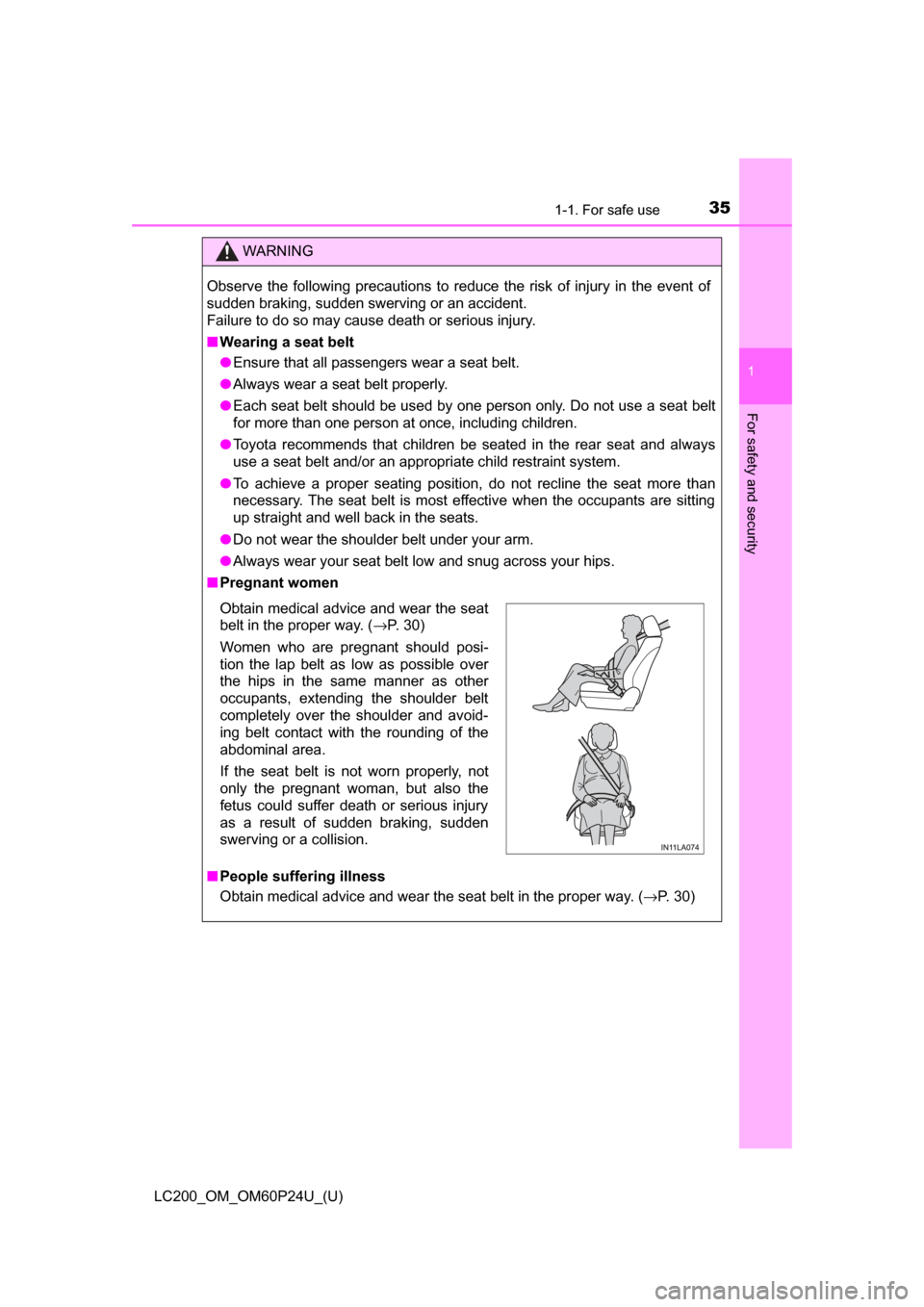
351-1. For safe use
LC200_OM_OM60P24U_(U)
1
For safety and security
WARNING
Observe the following precautions to reduce the risk of injury in the event of
sudden braking, sudden swerving or an accident.
Failure to do so may cause death or serious injury.
■Wearing a seat belt
● Ensure that all passengers wear a seat belt.
● Always wear a seat belt properly.
● Each seat belt should be used by one person only. Do not use a seat belt
for more than one person at once, including children.
● Toyota recommends that children be seated in the rear seat and always
use a seat belt and/or an appropriate child restraint system.
● To achieve a proper seating position, do not recline the seat more than
necessary. The seat belt is most effective when the occupants are sitting
up straight and well back in the seats.
● Do not wear the shoulder belt under your arm.
● Always wear your seat belt low and snug across your hips.
■ Pregnant women
■ People suffering illness
Obtain medical advice and wear the seat belt in the proper way. ( →P. 30)
Obtain medical advice and wear the seat
belt in the proper way. (→P. 30)
Women who are pregnant should posi-
tion the lap belt as low as possible over
the hips in the same manner as other
occupants, extending the shoulder belt
completely over the shoulder and avoid-
ing belt contact with the rounding of the
abdominal area.
If the seat belt is not worn properly, not
only the pregnant woman, but also the
fetus could suffer death or serious injury
as a result of sudden braking, sudden
swerving or a collision.
Page 39 of 608

391-1. For safe use
LC200_OM_OM60P24U_(U)
1
For safety and security
◆SRS side and curtain shield airbagsSRS front side airbags
Can help protect the torso of the front seat occupants
SRS rear side airbags
Can help protect the torso of occupants in the second outboard
seats
SRS curtain shield airbags
Can help protect primarily the head of occupants in the outboard
seats
3
4
5
Page 40 of 608
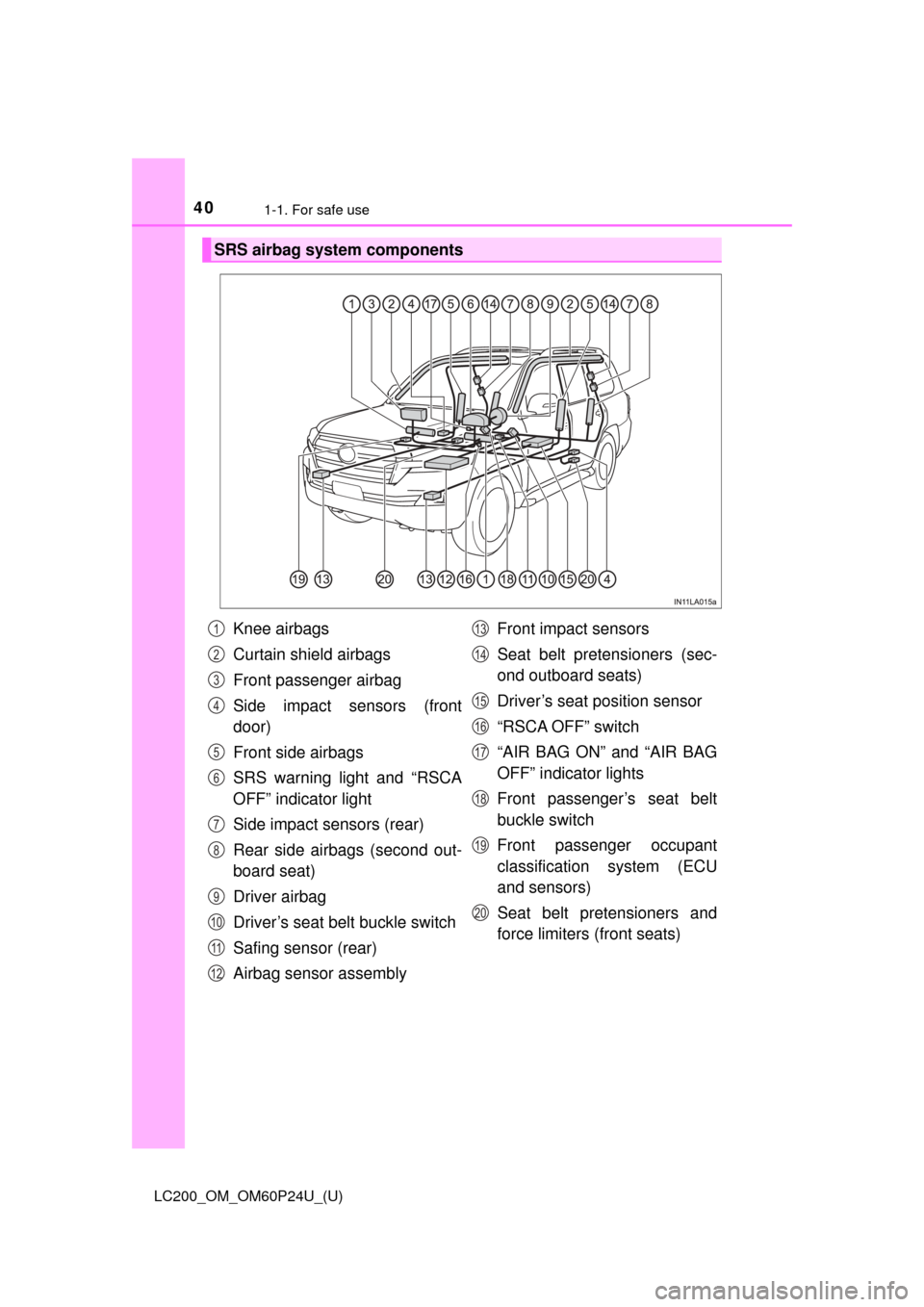
401-1. For safe use
LC200_OM_OM60P24U_(U)
SRS airbag system components
Knee airbags
Curtain shield airbags
Front passenger airbag
Side impact sensors (front
door)
Front side airbags
SRS warning light and “RSCA
OFF” indicator light
Side impact sensors (rear)
Rear side airbags (second out-
board seat)
Driver airbag
Driver’s seat belt buckle switch
Safing sensor (rear)
Airbag sensor assemblyFront impact sensors
Seat belt pretensioners (sec-
ond outboard seats)
Driver’s seat position sensor
“RSCA OFF” switch
“AIR BAG ON” and “AIR BAG
OFF” indicator lights
Front passenger’s seat belt
buckle switch
Front passenger occupant
classification system (ECU
and sensors)
Seat belt pretensioners and
force limiters (front seats)1
2
3
4
5
6
7
8
9
10
11
12
13
14
15
16
17
18
19
20
Page 41 of 608

411-1. For safe use
LC200_OM_OM60P24U_(U)
1
For safety and security
Your vehicle is equipped with ADVANCED AIRBAGS designed based
on the US motor vehicle safety standards (FMVSS208). The airbag
sensor assembly (ECU) controls airbag dep loyment based on infor-
mation obtained from the sensors et c. shown in the system compo-
nents diagram above. This informat ion includes crash severity and
occupant information. As the airbags deploy, a chemical reaction in
the inflators quickly fills the airbag s with non-toxic gas to help restrain
the motion of the occupants.
WARNING
■ SRS airbag precautions
Observe the following precautions regarding the SRS airbags.
Failure to do so may cause death or serious injury.
● The driver and all passengers in the vehicle must wear their seat belts
properly.
The SRS airbags are supplemental devices to be used with the seat belts.
● The SRS driver airbag deploys with considerable force, and can cause
death or serious injury especially if the driver is very close to the airbag.
The National Highway Traffic Safety Administration (NHTSA) advises:
Since the risk zone for the driver’s airbag is the first 2 - 3 in. (50 - 75 mm)
of inflation, placing yourself 10 in. (250 mm) from your driver airbag pro-
vides you with a clear margin of safety. This distance is measured from
the center of the steering wheel to your breastbone. If you sit less than 10
in. (250 mm) away now, you can change your driving position in several
ways:
• Move your seat to the rear as far as you can while still reaching the ped-
als comfortably.
• Slightly recline the back of the seat. Although vehicle designs vary,
many drivers can achieve the 10 in. (250 mm) distance, even with the
driver seat all the way forward, simply by reclining the back of the seat
somewhat. If reclining the back of your seat makes it hard to see the
road, raise yourself by using a firm, non-slippery cushion, or raise the
seat if your vehicle has that feature.
• If your steering wheel is adjustable, tilt it downward. This points the air-
bag toward your chest instead of your head and neck.
The seat should be adjusted as recommended by NHTSA above, while
still maintaining control of the foot pedals, steering wheel, and your view
of the instrument panel controls.